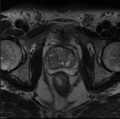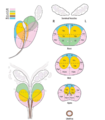Difference between revisions of "2017 Winter Project Week/ProstateSectorSegmentation"
From NAMIC Wiki
| (6 intermediate revisions by 2 users not shown) | |||
| Line 5: | Line 5: | ||
File:Prostate_MRI.PNG|Transversal slice of Prostate MRI. | File:Prostate_MRI.PNG|Transversal slice of Prostate MRI. | ||
File:SectorMap_Prostate.PNG|Sector Map according to PI-RADS v2. | File:SectorMap_Prostate.PNG|Sector Map according to PI-RADS v2. | ||
| + | File:ManualSegmentations.PNG|Manual Segmentation on transversal slices. | ||
</gallery> | </gallery> | ||
| Line 11: | Line 12: | ||
* Anneke Meyer, University of Magdeburg (Germany) | * Anneke Meyer, University of Magdeburg (Germany) | ||
* Andrey Fedorov, BWH | * Andrey Fedorov, BWH | ||
| + | * Alireza Mehrtash, BWH | ||
| + | * Christian Hansen, University of Magdeburg (Germany) | ||
| + | * Teodora Szasz, University of Chicago | ||
==Project Description== | ==Project Description== | ||
| Line 26: | Line 30: | ||
* Generation/ Refinement of ground truth data | * Generation/ Refinement of ground truth data | ||
* Creation of a 3D sector model | * Creation of a 3D sector model | ||
| − | * | + | * Test with ProstateX challenge dataset (where zones of findings are given) to predict the zone with Deep Learning |
| − | + | * if more training data is available: deep learning for an automatic sector segmentation | |
| − | * if more training data is available: deep learning | + | * Try atlas-based segmentation approach to map zone segmentations on more datasets |
| + | |||
| + | |||
| | | | ||
<!-- Progress and Next steps bullet points (fill out at the end of project week) --> | <!-- Progress and Next steps bullet points (fill out at the end of project week) --> | ||
| − | * | + | * Creation of 3 zone segmentations of the prostate (different volumes) |
| + | * Prediction of zones for specific locations in ProstateX dataset with Deep Learning is in progress | ||
| + | * Next Steps: Create 3D model with higher resolution. Atlas based segmentation on more publicly available data. | ||
|} | |} | ||
==Background and References== | ==Background and References== | ||
<!-- Use this space for information that may help people better understand your project, like links to papers, source code, or data --> | <!-- Use this space for information that may help people better understand your project, like links to papers, source code, or data --> | ||
Latest revision as of 15:52, 13 January 2017
Home < 2017 Winter Project Week < ProstateSectorSegmentationKey Investigators
- Anneke Meyer, University of Magdeburg (Germany)
- Andrey Fedorov, BWH
- Alireza Mehrtash, BWH
- Christian Hansen, University of Magdeburg (Germany)
- Teodora Szasz, University of Chicago
Project Description
| Objective | Approach and Plan | Progress and Next Steps |
|---|---|---|
|
|
|



